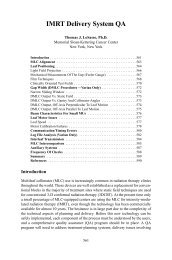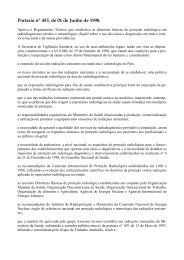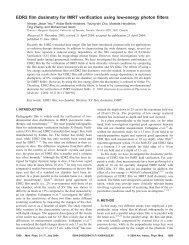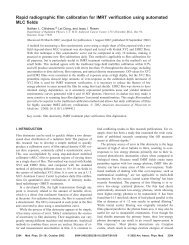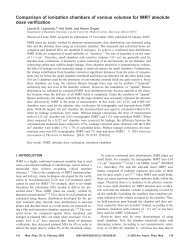intensity-modulated radiotherapy: current status and issues
intensity-modulated radiotherapy: current status and issues
intensity-modulated radiotherapy: current status and issues
Create successful ePaper yourself
Turn your PDF publications into a flip-book with our unique Google optimized e-Paper software.
IMRT: <strong>current</strong> <strong>status</strong> <strong>and</strong> <strong>issues</strong> of interest ● IMRT CWG<br />
897<br />
formation regarding the dose at selected points, they are<br />
impractical for providing 2D dose-distribution measurements.<br />
Ideally, a 2D dosimeter should be linear <strong>and</strong> waterequivalent.<br />
Radiochromic film conforms to these requirements,<br />
but the techniques required for accurate dose<br />
measurements have not been universally adopted, <strong>and</strong> the<br />
film still requires doses of 20 Gy. Radiographic film is not<br />
water-equivalent, <strong>and</strong> the precision of the film is strongly<br />
linked to the quality of the measurement <strong>and</strong> film processing<br />
techniques. However, radiographic film <strong>and</strong> processing<br />
equipment are universally available in RT departments.<br />
Therefore, it merits consideration for testing <strong>and</strong> periodic<br />
QA of IMRT dose distributions.<br />
Considerations regarding the film sensitivity <strong>and</strong> other<br />
<strong>issues</strong> lead to the conclusion that it is quite difficult to use<br />
film as an absolute dosimeter <strong>and</strong> that it also requires<br />
significant effort to use as a precise relative dosimeter. One<br />
useful method based on film is to use it to localize the<br />
high-gradient regions in the distribution, because precise<br />
dose measurements are not required in regions of a highdose<br />
gradient if the position of that gradient is all that is<br />
being measured. This task is precisely the task that is ill<br />
suited for point dosimeters like ion chambers. Although this<br />
does not guarantee that the dose distribution is correct<br />
everywhere, it does provide a useful QA tool.<br />
A relatively new dosimeter, BANG (bis, acrylamide,<br />
nitrogen, <strong>and</strong> gelatin) gel, may prove useful for IMRT<br />
dose-distribution measurements (171). The dosimeter is a<br />
gelatinous medium that relies on the polymerization <strong>and</strong><br />
cross-linking produced by ionizing radiation <strong>and</strong> subsequent<br />
increases in the solvent proton relaxation in the presence of<br />
the polymer. The increased proton relaxation rate (R 2 <br />
1/T 2 ) can be imaged using MRI. The gel is irradiated using<br />
IMRT delivery <strong>and</strong> subsequently imaged using a clinical<br />
MRI unit. T 1 - <strong>and</strong> T 2 -weighted scans are obtained for each<br />
gel, <strong>and</strong> the volumetric distribution of R 2 is determined<br />
using these scans. A monotonic relationship exists between<br />
R 2 <strong>and</strong> the absorbed dose, but because the gel’s radiation<br />
sensitivity is batch dependent, some gels must be irradiated<br />
to known doses <strong>and</strong> scanned to obtain a dose–calibration<br />
curve. A measurement of the full 3D dose distribution is<br />
provided by this method. Currently, cost, thermal sensitivity,<br />
<strong>and</strong> the requirement of MRI for readout limit the use of<br />
this detector medium to a few dosimetry studies. Research<br />
is being conducted on optical scanning of gel dosimeters<br />
with subsequent reconstruction to obtain the 3D dose distributions<br />
(172, 173).<br />
In addition to the verification of IMRT dose distributions<br />
by measurement, Ma et al. (174) has reported on the use of<br />
Monte Carlo simulation as an independent check of the<br />
IMRT dose distribution.<br />
IMRT treatment plan test cases<br />
An essential component of thorough dosimetric verification<br />
is to study treatment plans <strong>and</strong> prescriptions that mimic<br />
the range of target volume <strong>and</strong> organ-at-risk geometries that<br />
will be used clinically. No complete set of IMRT plans has<br />
yet been developed for testing purposes, but the CWG<br />
believes the treatment plans should exhibit the following<br />
characteristics:<br />
A variety of target volume sizes <strong>and</strong> shapes should encompass<br />
the clinical range.<br />
The sizes <strong>and</strong> shapes of organs at risk, as well as the<br />
geometric relationship among them, should be modeled<br />
from clinical cases.<br />
The placement of targets should be varied to provide verification<br />
of the treatment planning <strong>and</strong> delivery systems<br />
throughout the available delivery <strong>and</strong> planning space.<br />
Full 3D plans should be performed. It may also be useful to<br />
study 2D plans using coplanar beams to provide a study<br />
of the dose calculation <strong>and</strong> delivery in experiments that<br />
are relatively insensitive to spatial errors in the orthogonal<br />
direction, allowing for more accurate measurements.<br />
These measurements can help to distinguish between<br />
dose measurement <strong>and</strong> planning or delivery errors in<br />
more complex IMRT plans.<br />
The treatment plan prescriptions used for testing purposes<br />
should provide regions of high-dose gradient such that<br />
the spatial localization accuracy can be determined in all<br />
three directions. This is particularly important if radiographic<br />
film is the only area dosimeter used.<br />
Anthropomorphic phantoms can be used for verifying the<br />
IMRT dose distribution, as shown by Verellen et al. (11)<br />
<strong>and</strong> Low et al. (12). Plans verified using these phantoms<br />
inspire confidence because of their human geometry appearance.<br />
They are also useful to test certain features of the<br />
immobilization system. However, they have some drawbacks.<br />
Because they are inhomogeneous, the evaluation of<br />
dose-distribution accuracy may be more difficult, especially<br />
if a homogeneous dose-calculation algorithm is used. Care<br />
must be taken to determine the relative location of the<br />
dosimeters <strong>and</strong> external alignment marks. Many anthropomorphic<br />
phantoms do not have regularly spaced dosimeter<br />
locations, <strong>and</strong> a measurement of their locations relative to<br />
the external alignment marks is required. For patient QA,<br />
anthropomorphic phantoms are often not better models of<br />
the patient than regular geometric phantoms. For example,<br />
in the head <strong>and</strong> neck, the diameter of the patient at a<br />
particular location relative to the alignment system may<br />
vary dramatically as a function of head rotation; therefore,<br />
if the anthropomorphic phantom <strong>and</strong> patient head tilt are<br />
different, the diameter <strong>and</strong>, consequently the dose, to a<br />
measurement region may differ.<br />
Although regular geometric phantoms do not look like<br />
patients, they have some very useful properties that enable<br />
the acquisition of accurate dose measurements. Regular<br />
geometric phantoms can be machined to tight spatial tolerances,<br />
<strong>and</strong> inserts for a variety of detectors can be fabricated<br />
for them. The relative location of the dosimeters <strong>and</strong> the<br />
phantom alignment marks (or other system) can be determined<br />
with a high degree of accuracy.<br />
One feature that is important to have available in the<br />
IMRT planning system is the ability to apply the fluence




